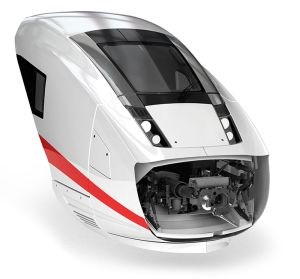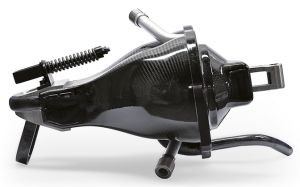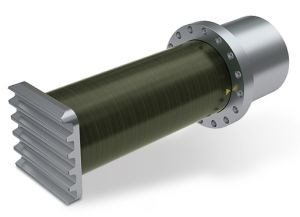Voith to introduce new composites for rail
German innovator offers lightweight while the U.K. “is at materials crossroad” for High Speed Rail 2 set to start construction in 2017.

Front end for the new ICx intercity trains of Deutsche Bahn (German Railways) featuring composites. SOURCE: Voith.
“Future rolling stock and infrastructure in the UK is at a materials crossroad,” noted Justin Cunningham, editor of magazine, in a recent blog He related that the national trade association, Composites UK (Herts), held an event to introduce composites to the rail industry for consideration on future projects such as High Speed 2, the high speed rail project to begin construction in 2017, initially extending from London to Birmingham (Phase 1) and then branching to both Manchester and Leeds (Phase 2).
Cunningham relates, “There is genuine interest from the [UK] rail sector to lightweight, increase efficiency and better exploit materials technology. It knows it is behind the technology curve compared to other industries and wants to see improvement on the new projects now coming through. Indeed, Chinese trains and rail infrastructure have seen composites applied to great benefit.” But he is unsure when and how the UK rail industry will move forward with composites.
has no such hesitation. A division of the global engineering company (Heidenheim/Brenz, Germany), it has announced it will introduce a lateral energy absorber made of glass fiber reinforced plastics (GFRP) and aluminum at this year’s , International Trade Fair for Transport Technology (Sep. 23-26, Berlin, Germany). Offering a potential 60 percent weight reduction vs. standard steel absorbers, this new GFRP energy absorber was developed as part of the crash energy handling design of Voith Turbo’s new Galea vehicle head and front end systems.
New GFRP energy absorber offers 60 percent weight reduction vs. standard steel absorbers. SOURCE: Voith.
Train front ends must bear extreme loads when impacts occur. Voith’s new GFRP energy absorber comprises a fiber composite crash tube with an aluminum bearing and an anti-climber plate to provide excellent corrosion resistance and longevity. The system also complies with fire protection requirements according to the standard EN 45545-2:2013, class R7/HL3. With a total weight on only 70 to 95 kg (154 to 209 lb), it offers a constant energy absorption behavior at an outstanding energy to weight ratio, saving up to 600 kg (1,323 lb) per vehicle when equipped with four absorbers.
Other benefits include reduced size and mounting space required. In the case of a crash, the fiber composite crash tube defibrates (i.e. separates into its fibrous components), and thus can be easily deflected below the vehicle underframe. This allows mounting space behind the absorber to be reduced to 30 cm (≈ 1 ft). The absorber can also be adapted to the customer’s requirements, for force levels between 600 and 1600 kN at a maximum consumption length of 1000 mm (3.3 ft).
Galea integrated crash structure for rail vehicles offers maximum energy absorption at minimum weight. SOURCE: Voith.
Meanwhile, Voith’s designed for intercity railway transportation, is comprised mostly of GFRP, making it a lightweight solution compared with steel front ends. It not only significantly reduces the vehicle’s fuel consumption, but also minimizes the axle load and thus the wear of train and tracks. Alternatively, the load capacity of the train can be increased. Galea’s modular and flexible concept makes it a standard platform for all types of exterior designs, minimizing mounting and replacement times and, accordingly, the train’s downtimes.
Voith will also showcase the front nose of the new ICx high speed trains of Deutsche Bahn (German Railways). From 2016 on, these will gradually replace first the current Intercity/Eurocity trains and later the ICE1 and ICE2 vehicles. New developments in aerodynamics and optimization of interior space have realized savings in weight and energy consumption.
Voith explains that composites offer not only weight savings, but also the forming of complex geometries and free-form surfaces which help with innovative aerodynamic surfaces as well as specific geometries in an easy and cost-saving way.

The compact CFRP adapter coupler can be carried and fitted by one person alone. SOURCE: Voith.
Finally, carbon fiber reinforced plastics (CFRP) will be featured in Voith adapter couplers, used whenever a train needs to be towed. Legal requirements demand that every train has one on board. Versus steel, the CFRP adapter coupler cuts weight by nearly 50 percent, weighing only 23 kg (51 lb), and enabling it to be carried and mounted by only one person. This saves significant time and improves safety since adapter couplers are mostly used in emergency situations and must be fitted by train personnel on short notice. Furthermore, CFRP requires considerably less material thickness vs. steel to achieve the same strength characteristics, a definite benefit in the usually restricted mounting space between the vehicle front and the structure to which it is being attached.
Related Content
Bladder-assisted compression molding derivative produces complex, autoclave-quality automotive parts
HP Composites’ AirPower technology enables high-rate CFRP roof production with 50% energy savings for the Maserati MC20.
Read MoreHonda begins production of 2025 CR-V e:FCEV with Type 4 hydrogen tanks in U.S.
Model includes new technologies produced at Performance Manufacturing Center (PMC) in Marysville, Ohio, which is part of Honda hydrogen business strategy that includes Class 8 trucks.
Read MoreSMC composites progress BinC solar electric vehicles
In an interview with one of Aptera’s co-founders, CW sheds light on the inspiration behind the crowd-funded solar electric vehicle, its body in carbon (BinC) and how composite materials are playing a role in its design.
Read MoreCo-molding SMC with braided glass fiber demonstrates truck bed potential
Prepreg co-molding compound by IDI Composites International and A&P Technology enables new geometries and levels of strength and resiliency for automotive, mobility.
Read MoreRead Next
Ultrasonic welding for in-space manufacturing of CFRTP
Agile Ultrasonics and NASA trial robotic-compatible carbon fiber-reinforced thermoplastic ultrasonic welding technology for space structures.
Read MoreScaling up, optimizing the flax fiber composite camper
Greenlander’s Sherpa RV cab, which is largely constructed from flax fiber/bio-epoxy sandwich panels, nears commercial production readiness and next-generation scale-up.
Read MoreNext-gen fan blades: Hybrid twin RTM, printed sensors, laser shock disassembly
MORPHO project demonstrates blade with 20% faster RTM cure cycle, uses AI-based monitoring for improved maintenance/life cycle management and proves laser shock disassembly for recycling.
Read More














